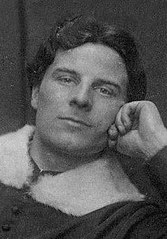The English Hymnal
 Front cover | |
| Editors | |
|---|---|
| Language | English |
| Subject | Religioussheet music |
| Publisher | Oxford University Press |
Publication date | 1906 |
| Publication place | United Kingdom |
| Media type | Print (hardback) |
| ISBN | 978-0-19-231111-5(later edition) |
| Text | The English HymnalatWikisource |
The English Hymnalis ahymn bookwhich was published in 1906[1]for theChurch of EnglandbyOxford University Press.It was edited by the clergyman and writerPercy Dearmerand the composer and music historianRalph Vaughan Williams,and was a significant publication in the history ofAnglican church music.
Methodology
[edit]The preface to the hymnal describes itself as "a collection of the best hymns in the English language."[2]Much of the contents was used for the first time at St Mary's,Primrose Hill,in north London,[citation needed]and the hymnbook could be considered a musical companion toThe Parson's Handbook,Dearmer's 1899 manifesto on English church ceremonial, vestments and furnishings.[3][4]
The high quality of the music is due largely to the work of Vaughan Williams as musical editor. The standard of the arrangements and original compositions made it a landmark in English hymnody[5]and one of the most influential hymnals of the 20th century.[6]The hymnal included the first printing of several arrangements and hymn settings by Vaughan Williams. Among the most famous areSine Nomine,a new tune toFor All the Saints;[7][8]andYe Watchers and Ye Holy Ones,a new text for the hymn tuneLasst uns erfreuen.The hymnal also includes manyplainsongmelodies (in both plainsong and modernised notation).
Reception
[edit]After its publication, use of the hymnal had been banned for a time by theArchbishop of Canterbury.[2]Ultimately,The English Hymnal,along with theChurch Hymnal for the Christian Year,"undermined the uniformity of the Church of England and successfully challenged [the] hegemony" ofHymns Ancient and Modern,[9]of which a new and revised edition had been published two years previous.[10]
The book is a characteristic green colour and is sometimes associated with thehigh-churchorAnglo-Catholicmovement withinAnglicanism.[11]When the book was published, high andbroad churchesusedHymns Ancient and Modernandevangelicalchurches normally used theHymnal Companion to the Book of Common Prayer.The hymnal has, however, been adopted not only in various movements of Anglicanism but also in several other denominations in Britain, such as someRoman Catholicchurches.[citation needed]
Revisions
[edit]A new edition ofThe English Hymnalwas issued in 1933,[12]which principally had better accompaniments by J. H. Arnold to the plainsong melodies, and over 100 new tunes. This was achieved without renumbering hymns or extending the book excessively. Instead many formerly duplicated tunes were changed to new tunes. Where unique tunes were changed the old tunes were moved into an appendix, which is often referred to as "the chamber of horrors",[13][14][15]a description attributed to Vaughan-Williams himself.[16][17][18][19][20]
A supplement to the hymnal,English Praise,was published in 1975.[21]
The New English Hymnalappeared in 1986,[22]and its supplement,New English Praisein 2006, both under the imprint of the Canterbury Press, nowSCM Canterbury Press.TheRevised English Hymnalwas published on 29 November 2023.[23]
See also
[edit]- List of English-language hymnals by denomination
- Songs of Praise(hymnal),a broader selection of hymns edited by Dearmer, Shaw, and Vaughan Williams in 1925
References
[edit]Footnotes
[edit]- ^Wilkinson 1985,p. 140.
- ^abHowse 2006.
- ^Palmer Heathman 2017,p. 184.
- ^"Medievalism and Ritualism – Part 1: Percy Dearmer and the scholarly context of the Parson's Handbook".Medieval Art.6 July 2018.Retrieved2 March2021.
- ^"English Hymnal".The Canterbury Dictionary of Hymnology.Canterbury Press.
- ^Wilson-Dickson 2003,p. 234.
- ^Wilkinson 1985,p. 131.
- ^Hawes 2000.
- ^Wilkinson 1985,p. 52.
- ^Leaver 1990,p. 482.
- ^Kilcrease 2017,p. 93;Leaver 1990,pp. 483, 503.
- ^Dickinson 1956,p. 244.
- ^Palmer Heathman 2017,pp. 183–200.
- ^Sceats 1951,pp. 235–246.
- ^Anderson 2004,pp. 165–166.
- ^"Ralph Vaughan Williams".hymnsandcarolsofchristmas.Retrieved30 May2021.
- ^Bradley 2005,pp. 231–241.
- ^"Tune army".The Northern Echo.31 January 2008.Retrieved30 May2021.
- ^Garland, M. (2020),Brightest and best(PDF)
- ^Giles, G. (2020)."Sweet Sacrament Divine"(PDF).Church Music Quarterly.RSCM:44–46.
- ^Luff 2007,pp. 17–18.
- ^Luff 2007,p. 19.
- ^"Revised English Hymnal here at last!".RSCM.1 December 2023.Retrieved2 December2023.
Bibliography
[edit]- Anderson, E. Byron (2004). "J. R. Watson, An Annotated Anthology of Hymns. Oxford: Oxford University Press, 2002. xvii+452 pp. $55.00 (cloth)".The Journal of Religion.84(1): 165–166.doi:10.1086/382339.ISSN0022-4189.
- Bradley, I. C. (2005). "Vaughan Williams' Chamber of Horrors: Changing Attitudes to Victorian Hymns". In Alan Luff (ed.).Strengthen for Service: 100 Years of the English Hymnal, 1906-2006.Canterbury Press. pp. 231–241.ISBN978-1-85311-662-9.
- Dickinson, A. E. F. (1956). "Some Thoughts About 'The English Hymnal'".The Musical Times.97(1359): 243–245.doi:10.2307/936457.ISSN2397-5318.JSTOR936457.
- Hawes, John (2000)."The English Hymnal".London: Parish Church of St Mary-the-Virgin, Primrose Hill. Archived fromthe originalon 17 February 2006.Retrieved13 November2018.
- Howse, Christopher (25 November 2006)."Sacred Mysteries".The Telegraph.London.Retrieved13 November2018.
- Kilcrease, Bethany (2017).The Great Church Crisis and the End of English Erastianism, 1898–1906.Abingdon, England: Routledge.ISBN978-1-317-02992-2.
- Leaver, Robin A. (1990). "British Hymnody, 1900–1950". In Glover, Raymond F. (ed.).The Hymnal 1982 Companion.Vol. 1. New York: Church Hymnal Corporation. pp. 474–504.ISBN978-0-89869-143-6.
- Luff, Alan (2007). "The Twentieth-Century Hymn Explosion: Where the Fuse Was Lit".The Hymn.58(4): 11–21.ISSN0018-8271.
- Palmer Heathman, Katie (2017)."'Lift Up a Living Nation': Community and Nation, Socialism and Religion inThe English Hymnal,1906 ".Cultural and Social History.14(2): 183–200.doi:10.1080/14780038.2017.1290995.ISSN1478-0046.
- Sceats, Godfrey (1951). "English Hymnal and Hymns A. & M".Music and Letters.XXXII(3): 235–246.doi:10.1093/ml/XXXII.3.235.ISSN0027-4224.
- Wilkinson, Richard William (1985).A History of Hymns Ancient and Modern(PhD thesis). Hull, England: University of Hull.Retrieved13 November2018.
- Wilson-Dickson, Andrew(2003) [1992].The Story of Christian Music: From Gregorian Chant to Black Gospel; An Authoritative Illustrated Guide to All the Major Traditions of Music for Worship.Minneapolis, Minnesota: Fortress Press.ISBN978-0-8006-3474-2.
Further reading
[edit]- The English Hymnal with Tunes(2nd ed.). London: Oxford University Press. 1933.
- Luff, Alan, ed. (2005).Strengthen for Service: 100 Years of the English Hymnal, 1906–2006.Norwich, England: Canterbury Press.ISBN978-1-85311-662-9.
- Routley, Erik R.(1956). "The English Hymnal, 1906–56".Hymn Society of Great Britain and Ireland Bulletin.4(2): 17–26.
External links
[edit]- The English hymnal, with tunes (~100 EU copyright pages redacted).London: Oxford University Press. 1906.
- The English hymnal.London: Oxford University Press. 1933.(text only)


